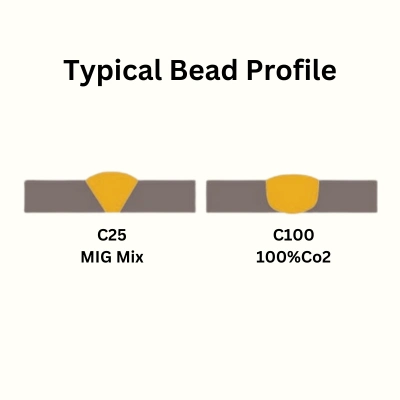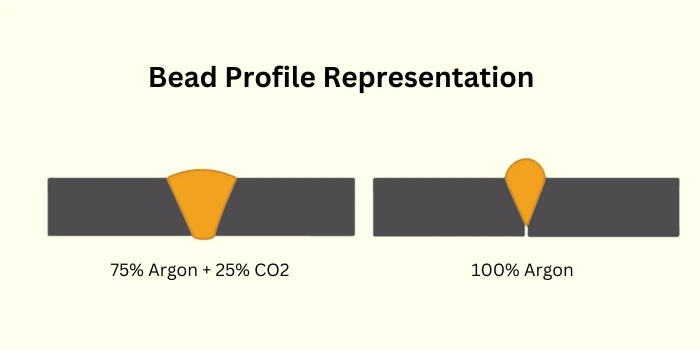MIG Welding with 100% Co2 Shielding Gas | Pros & Cons with Pro Tips
Updated: 9 Dec 2023
200
Metal Inert Gas (MIG) welding is a widely used welding process, and one of the critical factors for the success of MIG welding is the choice of shielding gas.
It is important to remember that a mixture of argon and carbon dioxide (CO2) is commonly used for MIG welding. But this guide will dive into the pros and cons of MIG welding with 100% CO2, why we use it, which equipment is required, and much more. So, let’s go deep into it.
Why Use Pure Co2 for MIG Welding?
If you want to use 100% CO2 (carbon dioxide) for MIG welding, then you must understand the advantages and disadvantages. This will help you to make informed decisions for welding with this kind of shielding gas.
Advantages of Using Pure CO2 in MIG Welding:
1. Cost-Effectiveness:
One of the primary reasons welders choose 100% CO2 is its cost-effectiveness. CO2 is less expensive than mixed gases and can be an attractive choice for those looking to balance quality with affordability.
2. Deep Penetration:
MIG welding with 100% CO2 can penetrate more than shielding gases. This can be beneficial when working with thicker materials that allow you to make good weld bead penetration and overall joint strength.
3. High Heat Output:
CO2 produces a hot arc compared to other shielding gases. This heat is helpful when welding in challenging conditions, such as windy outdoor environments, or when working with metals that require higher temperatures for proper fusion.
Disadvantages of Using Pure CO2:
1. Increase Spatter:
Pure CO2 produces more Spatter during welding compared to mixed gases. Spatter is the metal particles that scatter and adhere to the welded surface, requiring additional cleanup.
2. Arc Stability:
CO2 has a more irregular arc than mixed gases and affects the stability of the welding process. This leads to challenges in achieving a smooth and consistent weld bead.
3. Not Suitable for All Materials:
CO2 is suitable for welding carbon steel; conversely, it is not the best choice for materials like stainless steel or aluminum. Mixed gases are often preferred for welding a variety of materials.
4. Impact on Welding Equipment:
The high reactivity of CO2 compared to inert gases can lead to increased wear and tear on welding equipment, including the welding gun.
C100 Vs. C25 (Comparison Between Pure and Mixture of CO2)
Understanding the difference between C100 and C25 is essential because the percentage of carbon dioxide in MIG welding has a significant effect.

© weldingvilla.com – Image usage rights
C100 (100% Carbon Dioxide):
Here are the main benefits of pure carbon dioxide in MIG welding.
- Cost-Effectiveness
- Deep Penetration
- Higher Heat Output
C25 (75% Argon, 25% Carbon Dioxide):
Here are the main benefits of C25 in MIG welding.
- Stability and Smooth Arc
- Versatility
- Reduced Welding Fumes

© weldingvilla.com – Image usage rights
Considerations for Choosing Between C100 and C25:
Choose your shielding gas wisely in MIG welding based on material and thickness considerations. Opt for C100 for deep penetration in thicker materials, while the versatile C25 is suitable for various thicknesses.
Balance cost and performance according to your budget, with C100 being more cost-effective. If aesthetics matter, especially for thin materials, C25’s stable arc makes it preferable for achieving clean and pleasing weld beads.
Now, watch the complete process in the video below with complete details and explanations.
Equipment Considerations: What’s Needed To MIG Weld With 100% CO2?
Selecting the right equipment while MIG welding is crucial because this will enhance your welding quality, provide personal protection, and support your entire process.
- 1. Welding Machine: Ensure you have a MIG welding machine capable of using 100% CO2 as a shielding gas. Check the machine specifications to confirm compatibility.
- 2. CO2 Gas Cylinder: Acquire a CO2 gas cylinder with the appropriate pressure rating and size for your welding needs. Verify that it meets safety standards and is suitable for welding applications.
- 3. Regulator and Flowmeter: Use a regulator and flowmeter designed for MIG welding with CO2. These control the gas flow rate, ensuring a consistent and optimal level for the welding process.
- 4. MIG Gun and Consumables: Select a MIG gun suitable for 100% CO2 welding. Ensure the gun and its consumables, such as contact tips and nozzles, are compatible with the gas and your welding machine.
- 5. Drive Rolls and Wire: Adjust or replace drive rolls in your welding system to accommodate the specific wire diameter recommended for use with 100% CO2. Ensure your wire spool matches the welding requirements.
- 6. Personal Protective Equipment (PPE): Prioritize safety with appropriate PPE, including a welding helmet, gloves, welding jacket, and safety glasses. Ensure that your PPE is suitable for MIG welding and provides adequate protection.
- 7. Work Area Ventilation: Since MIG welding with 100% CO2 produces fumes, ensure proper ventilation in your work area. Use exhaust fans or work in well-ventilated spaces to minimize exposure to welding fumes.
- 8. Welding Table or Surface: Set up a stable and non-flammable welding table or surface to support your workpieces. Conform, it is properly grounded to prevent electrical hazards.
Tips for Successful MIG Welding with 100% CO2:
- 1. Adjusting Settings: The high heat output of 100% CO2 depends on the welding of machine settings accordingly. This includes finding the proper voltage and wire feed speed to achieve optimal results for the specific welded material and thickness.
- 2. Proper Ventilation: While CO2 is a suitable shielding gas, ensuring proper ventilation in the welding area is essential. Sufficient ventilation helps to spread any fumes and prevents harmful gases.
- 3. Selecting the Right Wire: Choosing the appropriate welding wire is crucial for successful MIG welding with 100% CO2. Consult with welding supply professionals to determine the right wire type and diameter for your specific welding application.
- 4. Practice and Technique: As with any welding process, practice and proper technique are crucial to achieving high-quality welds. Take the time to familiarize yourself with the characteristics of MIG welding with pure CO2 through practice.
Frequently Asked Questions:
How much CO2 flow for MIG Welding?
The recommended CO2 flow rate for MIG welding typically falls in the 15-20 l/min range. However, specific requirements may vary based on material thickness, welding parameters, and equipment specifications.
Can I use 100% CO2 for MIG Welding on all materials?
100% CO2 is suitable for carbon steels, while it is not the best choice for welding other materials like stainless steel or aluminum. Check material compatibility before use.
Does MIG Welding with 100% CO2 produce more Spatter?
Yes, 100% CO2 produces more Spatter than mixed gases. Proper settings and techniques can help minimize Spatter for clean welds.
Final Thoughts:
MIG welding with 100% CO2 offers a cost-effective solution with advantages such as deep penetration and higher heat output, which are especially suitable for carbon steels. However, it has challenges like increased Spatter and a less stable arc.
Choosing between 100% CO2 and a mix like C25 depends on material type, thickness, and desired weld appearance. Proper equipment selection, ventilation, and mastering techniques are crucial for successful welding.
Now it’s up to you where and how you will deal with it. Yeah! You can leave a comment if you have a problem related to the same query or others in welding. Our team will reach you in a couple of minutes. Be kind and remember to share this information in your welding community. Thanks for spending time with us.
Please Write Your Comments